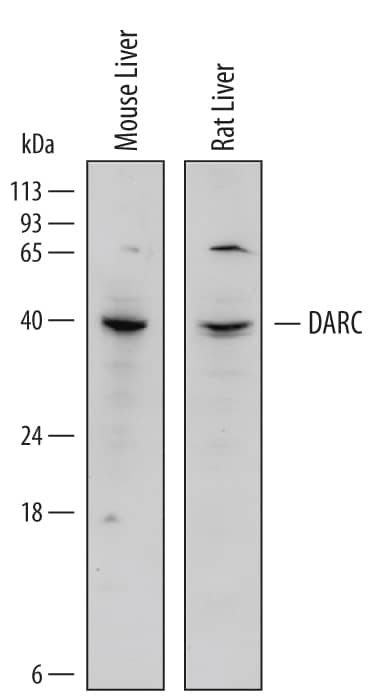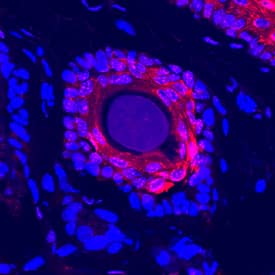Mouse/Rat DARC Antibody
R&D Systems, part of Bio-Techne | Catalog # AF6695


Key Product Details
Species Reactivity
Applications
Label
Antibody Source
Product Specifications
Immunogen
Met1-Pro61, Ala115-Cys127, Ser186-Lys205, Tyr264-Asn285
Accession # NP_034175
Specificity
Clonality
Host
Isotype
Scientific Data Images for Mouse/Rat DARC Antibody
Detection of Mouse and Rat DARC by Western Blot.
Western blot shows lysates of mouse liver tissue and rat liver tissue. PVDF Membrane was probed with 1 µg/mL of Sheep Anti-Mouse/Rat DARC Antigen Affinity-purified Polyclonal Antibody (Catalog # AF6695) followed by HRP-conjugated Anti-Sheep IgG Secondary Antibody (Catalog # HAF016). A specific band was detected for DARC at approximately 40 kDa (as indicated). This experiment was conducted under reducing conditions and using Immunoblot Buffer Group 1.Detection of DARC in Mouse Splenocytes by Flow Cytometry.
Mouse splenocytes were stained with Rat Anti-Mouse TER-119 APC-conjugated Monoclonal Antibody (Catalog # FAB1125A) and either (A) Sheep Anti-Mouse/Rat DARC Antigen Affinity-purified Polyclonal Antibody (Catalog # AF6695) or (B) Normal Sheep IgG Control (Catalog # 5-001-A) followed by Allophycocyanin-conjugated Anti-Sheep IgG Secondary Antibody (Catalog # F0127).Detection of DARC in HEK293 Human Cell Line Transfected with Mouse DARC and eGFP by Flow Cytometry.
HEK293 human embryonic kidney cell line transfected with mouse DARC and eGFP was stained with either (A) Sheep Anti-Mouse/Rat DARC Antigen Affinity-purified Polyclonal Antibody (Catalog # AF6695) or (B) Normal Sheep IgG Control (Catalog # 5-001-A) followed by Allophycocyanin-conjugated Anti-Sheep IgG Secondary Antibody (Catalog # F0127).Applications for Mouse/Rat DARC Antibody
CyTOF-ready
Flow Cytometry
Sample: Mouse splenocytes and HEK293 human embryonic kidney cell line transfected with mouse DARC and eGFP
Immunohistochemistry
Sample: Perfusion fixed frozen sections of mouse skin (hair follicle)
Western Blot
Sample: Mouse liver tissue and rat liver tissue
Formulation, Preparation, and Storage
Purification
Reconstitution
Formulation
Shipping
Stability & Storage
- 12 months from date of receipt, -20 to -70 °C as supplied.
- 1 month, 2 to 8 °C under sterile conditions after reconstitution.
- 6 months, -20 to -70 °C under sterile conditions after reconstitution.
Background: DARC
DARC (Duffy Antigen Receptor for Chemokines; also CD234) is a 40-46 kDa glycoprotein member of the Duffy family of silent heptahelical chemokine receptors. It is expressed in liver and on select neurons, erythrocytes and the endothelium of postcapillary venules. Unlike traditional chemokine receptors, DARC cannot signal through G-proteins as it lacks a DRYLAIVHA cytoplasmic motif. DARC has three potential functions: first, it binds circulating inflammatory-type chemokines, serving as a repository for future chemokine release; second, it acts as a vehicle by which chemokines are transported from the abluminal to the luminal side of endothelium; and third, it complexes with signal-transducing chemokine receptors to create a nonsignaling heterodimer. Mouse DARC is 334 amino acids (aa) in length. It contains a 62 aa N-terminal extracellular region, and a 28 aa C-terminal cytoplasmic tail. There is one potential splice variant that shows a 42 aa substitution for aa 133-334. Collectively, over the four extracellular domains (aa 1-62, 115-127, 186-205, 264-285), mouse DARC shares 52% and 75% aa identity with human and rat DARC, respectively.
Long Name
Alternate Names
Gene Symbol
UniProt
Additional DARC Products
Product Documents for Mouse/Rat DARC Antibody
Product Specific Notices for Mouse/Rat DARC Antibody
For research use only


